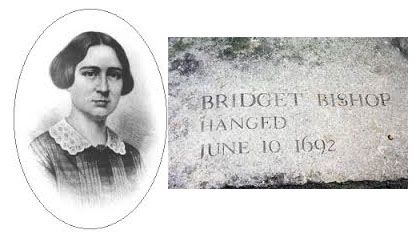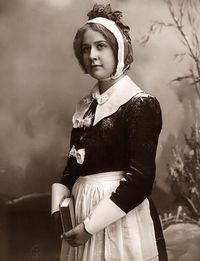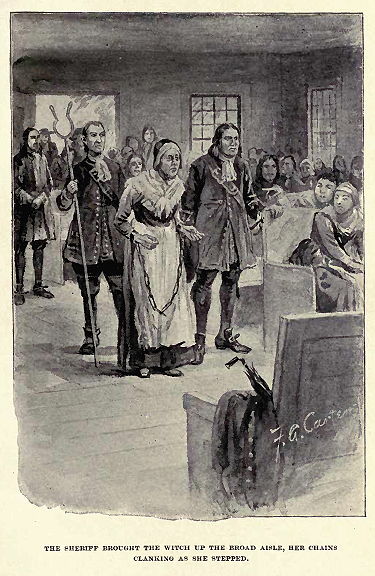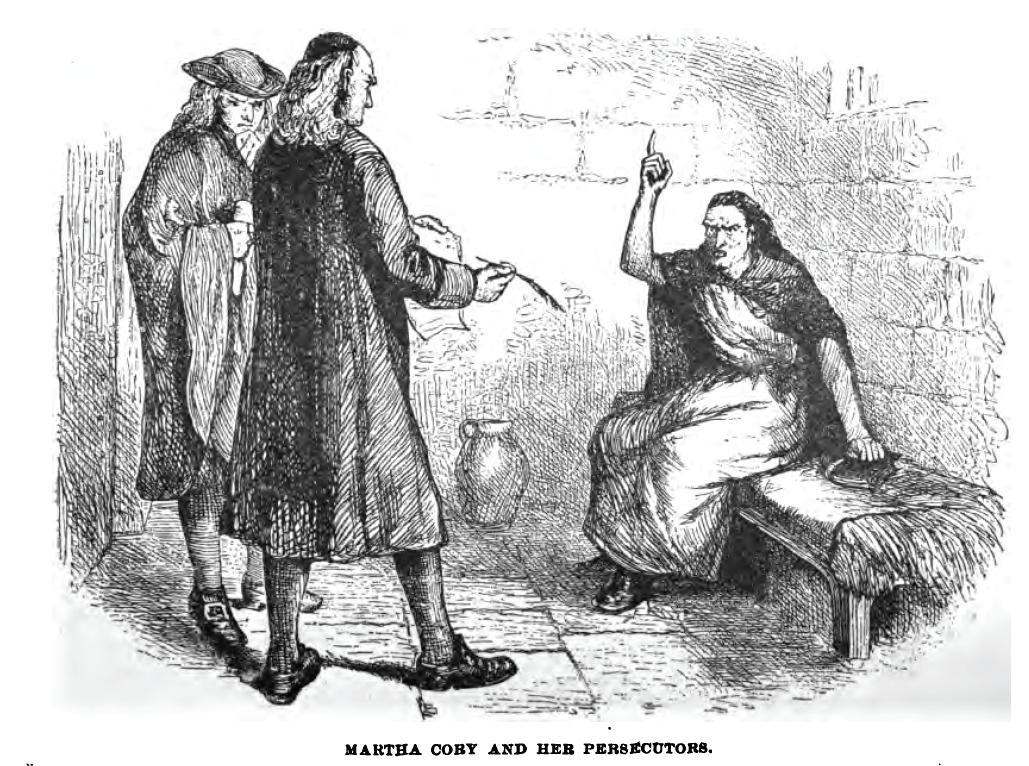The Salem Witch Trials are a dark and foreboding time period in the history of colonial America. Taking place in Salem village, Massachusetts, over 150 people were accused of witchcraft and 19 tragically executed. Often sensationalised and shrouded in myth, the Salem Witch Trials are a stark reminder of the dangers of mass hysteria, prejudice, and the consequences of intolerance.
This article will highlight the experiences of 5 notable victims of the Salem Witch Trials. Their stories are a testament to the fragility of justice and the human capacity for cruelty when fear takes hold.

The First Accusers – How the Salem Witch Trials Began
The main accusers in the Salem Witch Trials were a small circle of young girls, they would become known as the afflicted girls. The first accusers were, 11-year-old Elizabeth “Betty” Parris and 9-year-old Abigail Williams.
Living in the household of Reverend Samuel Parris, Betty and Abigail began to exhibit bizarre and inexplicable symptoms, such as convulsions, contortions of the limbs, barking and screaming fits. At the time, no medical doctors were able to identify the ailment.
Records show it was the children who first spoke of witchcraft accusations, they claimed to be afflicted by witches in the village. Many villagers believed Reverend Parris was a prime target for the devil, but as he was thought too strong to succumb to this dark magic, Parris’ daughter and niece were chosen as the weaker victims.
The initial accusations targeted three women – Sarah Good, a local beggar, Sarah Osborne, a scandalised widow, and Tituba, an enslaved woman owned by the Parris family.
While Sarah Good and Sarah Osborne denied the accusations and would plead innocent, Tituba made a confession. This only occurred after brutal and humiliating questioning and a physical exam to look for ‘marks of the devil’.
Tituba’s forced confession, combined with the girls’ constant accusations, sparked the notorious witch hunt known as the 1962 Salem Witch Trials.
March of 1692 the examinations of the Salem Witch Trials begin.
— History Dame (@history_dame) March 2, 2022
March 1: Tituba, Sarah Osborne and Sarah Good are taken for questioning. It will not take long for more individuals to be accused. Such as Rebecca Nurse, Martha Corey and more.
Accusations continued all spring. pic.twitter.com/3cjzOXAiGw
Tituba was convicted but thankfully managed to avoid execution, while Sarah Osbourne was sentenced to death, she died in prison before the hanging took place. Sarah Good was convicted and sentenced to execution – this was delayed due to pregnancy, however once losing her baby, Mercy Good, she was eventually killed on July 19 at the Proctor’s Ledge.
It is crucial to note that the motivations behind these accusations remain a subject of debate. Some suggest that the girls were influenced by the deeply religious and superstitious environment at the time of the trials, while others point to interpersonal conflicts and tensions in the community.
Regardless of the underlying factors, their accusations had devastating consequences, setting off a chain reaction of events that would result in the imprisonment, trials, and tragic executions of numerous innocent victims. The trials took place between February 1692 and May 1693.
5 Notable Victims of the Salem Witch Trials

1) Bridget Bishop
Bridget Bishop was the first person to be tried, convicted, and executed as a witch in Salem, Massachusetts. She was an elderly widow who had been accused of witchcraft a decade earlier, however she had originally been acquitted.
Bishop had a history of disputes with neighbours, dressed in an eccentric way and as a poor woman she fit the typical profile of those convicted of witchcraft. The trial was deeply flawed, characterised by spectral evidence (testimony about apparitions and dreams), which was highly controversial even in that era. This would become the theme of every case included in the trials.
This was the first case brought to the special Court of Oyer and Terminer. Bishop had ten witnesses testifying against her, all with claims of bewitching young girls, afflicting them with fits and causing other inexplicable ailments.
Bishop was found guilty and sentenced to death. Facing her execution by hanging at Proctor’s Ledge near Gallows Hill on June 10, 1962.

2) Sarah Good
Sarah Good was among the first three women accused of witchcraft. She was particularly vulnerable, as she was known to be impoverished and had a reputation for unconventional behaviour. Her social standing made her an easy target for those seeking to lay blame.
During her trial, Good maintained her innocence, but like all the accused, she faced a deeply flawed judicial process and was convicted and sentenced to death. Many victims who stood trial named her as a fellow witch in their forced confessions, describing her flying on a broom and attending witches gatherings.
Good’s last words were, “I am no more a witch than you are a wizard, and if you take away my life, God will give you blood to drink.” This haunting statement is a reminder of the grave injustices that unfolded during this time. She was executed on June 28, alongside Rebecca Nurse and three other women.
This sad case also extended to Good’s daughter, who was accused of witchcraft at four years old. She was kept in a filthy dungeon for months experiencing all kinds of abuse, her time imprisoned caused her great mental health issues that would follow her for the rest of her life.

3) John Proctor
John Proctor and his wife, Elizabeth Proctor, were accused by Mercy Lewis in March 1962. The girl claimed they had sent their spectres to cause her harm. She had initially only accused Elizabeth but as her husband vocally defended her, his name was also put forward.
John Proctor was known as a prosperous and outspoken individual, making him a threat to the social order. The Proctors were known for their independence and reluctance to conform to the strict Puritan norms of the time, which made them vulnerable to accusations. Elizabeth’s calm demeanour and scepticism towards the witch trials may also have been seen as evidence of guilt.
On top of this, the Putnam family, who had strong influence in the community, had long-standing disputes with the Proctors over land and property. 12-year-old Ann Putnam was a primary accuser in the trials. These tensions may have motivated the accusations against John and Elizabeth.
The Proctors were sentenced to death. John would be executed on August 19, while Elizabeth avoided this fate due to pregnancy delaying her hanging. She was eventually freed alongside 153 remaining prisoners in May 1963, when the trials ended. However, her ordeal was not over, all land and belongings had been taken by the state alongside her dowry, she spent much of her life fighting to regain her rights.

4) Rebecca Nurse
Rebecca Nurse was an elderly woman living in Salem Village, her name was put forward by Ann Putnam and Abigail Williams. Unlike many of the accused witches, she was a respected member of the community, known for her benevolence and piety.
Upon hearing of the warrant for her arrest, Nurse stated, “I am innocent as the child unborn, but surely, what sin hath God found out in me unrepented of, that He should lay such an affliction on me in my old age.” At 71, she was one of the oldest among those executed.
During her trial, Nurse maintained her innocence with a calm and unwavering resolve. Her faith and steadfastness in the face of the accusations endeared her to many observers who were increasingly skeptical of the witch trials. Thirty-nine of the most prominent members of the community signed a petition on her behalf.
Unfortunately, Nurse was found guilty and sentenced to hang. Her execution date was postponed many times due to an outpouring of support from the community, family and friends. She spent months in jail but was eventually executed July 19, alongside Sarah Good.
As was the custom for those executed, her body was buried in a shallow grave near the spot she was killed, this was because those found guilty were not deemed fit for a proper burial. It has been said her family returned after dark to dig up the body and laid her to rest respectfully on their land.

5) Martha Corey
Martha Corey was one of the last hangings in the Salem Witch Trials. She had been outspoken in her scepticism of the trials and outwardly denounced believing in witchcraft. Upon hearing Martha had claimed the accusers were lying, Anne Putnam and Mercy Lewis gave her name to the authorities, her husband Giles Corey was also accused.
Martha was a well esteemed member of the church, however many in the community viewed her mixed race, illegitimate son as proof of a sinful past. Giles also had a history of petty theft convictions that made it easy to paint the pair as sinners.
Throughout her trial, the accusers would copy her movements to create an illusion that she was controlling them, they would also claim they could see spectres sucking on her hand. Martha was ultimately convicted and sentenced to death.
Her husband, Giles, refused to plead guilty or not guilty. In an effort to make him talk the authorities performed forte et dure, a practice where the body is slowly crushed, he was ultimately pressed to death over three days. It is believed he refused to plead so his land and property could go to his sons, otherwise it would have been taken by the state.
Conclusion
These stories serve as powerful reminders of the grave consequences that can result from the abandonment of reason and justice in the face of irrationality.
The victims of the Salem Witch Trials are not merely a part of history; they provide a heartbreaking lesson in the importance of safeguarding the principles of fairness, justice, and due process.
This article is a short insight into the stories of over 150 people accused and 19 executed.
Written in memory of:
- Bridget Bishop
- Sarah Good
- Rebecca Nurse
- Martha Corey
- Elizabeth Howe
- Susannah Martin
- Sarah Wildes
- Rev. George Burroughs
- George Jacobs Sr.
- Martha Carrier
- John Proctor
- John Willard
- Mary Eastey
- Mary Parker
- Alice Parker
- Ann Pudeator
- Wilmot Redd
- Margaret Scott
- Samuel Wardwell Sr.
Don’t forget to check out our blog post: Samhain – How to Celebrate this Pagan Tradition

